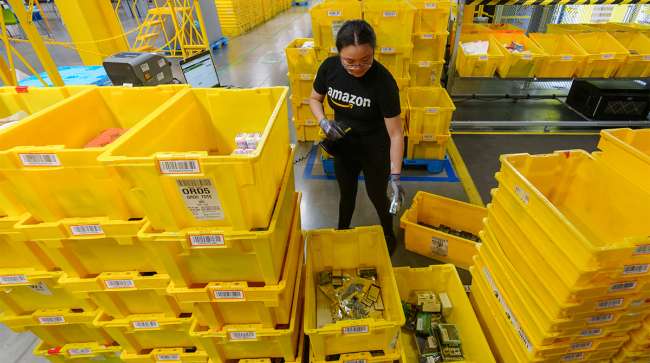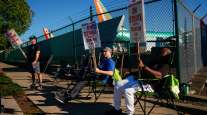Associated Press
US Adds a Robust 254,000 Jobs in September

[Stay on top of transportation news: Get TTNews in your inbox.]
WASHINGTON — America’s employers added a surprisingly strong 254,000 jobs in September, the latest evidence that the U.S. labor market is still solid enough to support steady hiring and a growing economy.
Last month’s hiring gain was up sharply from the 159,000 jobs that were added in August, and the unemployment dropped from 4.2% to 4.1%, the Labor Department said Oct. 4.
The latest figures suggest that many companies are still confident enough to fill jobs despite the continued pressure of high interest rates. Few employers are laying off workers, though many have grown more cautious about hiring.
The economy’s progress in taming inflation led the Federal Reserve last month to cut its benchmark interest rate for the first time in more than four years. The Fed said it wanted to ease the cost of borrowing to help bolster the job market.
Payroll employment rises by 254,000 in September; unemployment rate changes little at 4.1% #JobsReport #BLSdata https://t.co/ZwrVfLviqL — BLS-Labor Statistics (@BLS_gov) October 4, 2024
The economy’s resilience has come as a relief. Economists had expected that the Fed’s aggressive campaign to subdue inflation — it jacked up interest rates 11 times in 2022 and 2023 — would cause a recession. It didn’t. The economy kept growing even in the face of ever-higher borrowing costs for consumers and businesses.
Most economists say the Fed appears to have achieved the once unlikely prospect of a “soft landing’’ — in which high interest rates help vanquish inflation without triggering a recession — “is already secure.’’
The economy is weighing heavily on voters as the Nov. 5 presidential election nears. Many Americans are unimpressed by the job market’s durability and are still frustrated by high prices, which remain on average 19% above where they were in February 2021. That was when inflation began surging as the economy rebounded with unexpected speed and strength from the pandemic recession, causing severe shortages of goods and labor.
The public’s discontent with inflation and the economy under President Joe Biden has been a political burden for Vice President Kamala Harris in her race for the White House against former President Donald Trump.
Across the economy, though, most indicators look solid. The U.S. economy, the world’s largest, grew at a vigorous 3% annual pace from April through June, boosted by consumer spending and business investment. A forecasting tool from the Federal Reserve Bank of Atlanta points to slower but still healthy 2.5% annual growth in the just-ended July-September quarter.
The Services #ISMPMI Business Activity (59.9%) and New Orders (59.4%, highest since February 2023) indexes increased a combined 13 points in September. Survey respondents cited a new fiscal year at many organizations as an incentive to buy. https://t.co/CHmMOO8jOT #economy — Institute for Supply Management (@ism) October 3, 2024
The Institute for Supply Management, an association of purchasing managers, reported that America’s services businesses grew for a third straight month in September and at an unexpectedly fast pace. The economy’s service sector is closely watched because it represents more than 70% of U.S. jobs.
Last month, the nation’s households increased their spending at retailers. And even with hiring having slowed, Americans are enjoying unusual job security. Layoffs are near a record low as a percentage of employment. The number of people filing for unemployment benefits also remains near historically low levels.
Companies seem generally reluctant to let workers go even though some are also hesitant to expand their payrolls. That unusual dynamic may stem from many employers having been caught flat-footed and short of staff after the economy began roaring back from the pandemic recession.
Posted job openings, too, have declined steadily, to 8 million in August, after having peaked at 12.2 million in March 2022.
Workers have noticed the chillier environment for job seekers. Far fewer feel confident enough to leave their jobs to seek a better position. The number of Americans who are quitting their jobs has reached its lowest level since August 2020, when the economy was still reeling from COVID.
Two and a half years of high interest rates, it seems, have taken a toll on the job market. But relief might be coming.
Want more news? Listen to today's daily briefing above or go here for more info
The Fed last month slashed its benchmark interest rate by a hefty half-percentage point — its first and biggest rate cut since the 2020 recession. The central bank said it was encouraged by progress in its fight against inflation. Consumer prices were up 2.5% from a year earlier in August, barely above the Fed’s 2% inflation target and down dramatically from a year-over-year peak of 9.1% in June 2022.
The Fed’s focus shifted to supporting the job market as hiring slowed this summer and unemployment rose, even while remaining relatively low. The central bank has signaled that it expects to cut its key rate twice more this year — likely by modest quarter-points — and four additional times in 2025.
The expectation of lower borrowing costs could encourage employers to pick up the pace of hiring.




